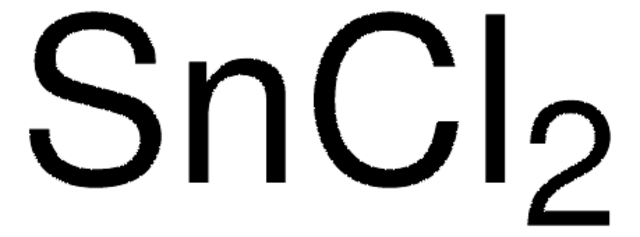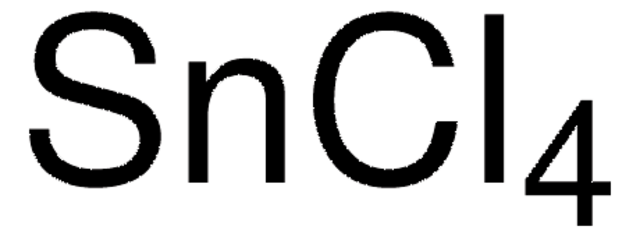96527
Tin(II) chloride dihydrate
suitable for AAS
Synonyme(s) :
Stannous chloride dihydrate
About This Item
Produits recommandés
Pureté
≥96.0% (RT)
Niveau de qualité
Forme
crystals
Technique(s)
AAS: suitable
Point d'ébullition
652 °C (lit.)
Pf
37-38 °C (dec.) (lit.)
Solubilité
hydrochloric acid: passes test
Traces d'anions
sulfate (SO42-): ≤20 mg/kg
Traces de cations
As: ≤1 mg/kg
Ca: ≤50 mg/kg
Cu: ≤10 mg/kg
Fe: ≤20 mg/kg
Hg: ≤5 μg/kg
K: ≤50 mg/kg
NH4+: ≤10 mg/kg
Na: ≤100 mg/kg
Pb: ≤50 mg/kg
Chaîne SMILES
O.O.Cl[SnH2]Cl
InChI
1S/2ClH.2H2O.Sn/h2*1H;2*1H2;/q;;;;+2/p-2
Clé InChI
FWPIDFUJEMBDLS-UHFFFAOYSA-L
Vous recherchez des produits similaires ? Visite Guide de comparaison des produits
Description générale
Application
- As a reducing agent for the determination of hydride forming species by AAS.
- In the conversion of organomercurials into inorganic mercury determined using a flow injection-cold vapor atomic absorption spectrometry
- In the determination of total mercury content, using atomic fluorescence spectroscopy and mercury speciation was performed using gas chromatography inductively coupled plasma mass spectrometry (GC-ICPMS).
Mention d'avertissement
Danger
Mentions de danger
Classification des risques
Acute Tox. 4 Inhalation - Acute Tox. 4 Oral - Aquatic Chronic 3 - Eye Dam. 1 - Met. Corr. 1 - Skin Corr. 1B - Skin Sens. 1 - STOT RE 2 Oral - STOT SE 3
Organes cibles
Cardio-vascular system, Respiratory system
Code de la classe de stockage
8B - Non-combustible corrosive hazardous materials
Classe de danger pour l'eau (WGK)
WGK 3
Point d'éclair (°F)
Not applicable
Point d'éclair (°C)
Not applicable
Équipement de protection individuelle
Eyeshields, Faceshields, Gloves, type P3 (EN 143) respirator cartridges
Faites votre choix parmi les versions les plus récentes :
Déjà en possession de ce produit ?
Retrouvez la documentation relative aux produits que vous avez récemment achetés dans la Bibliothèque de documents.
Les clients ont également consulté
Notre équipe de scientifiques dispose d'une expérience dans tous les secteurs de la recherche, notamment en sciences de la vie, science des matériaux, synthèse chimique, chromatographie, analyse et dans de nombreux autres domaines..
Contacter notre Service technique









